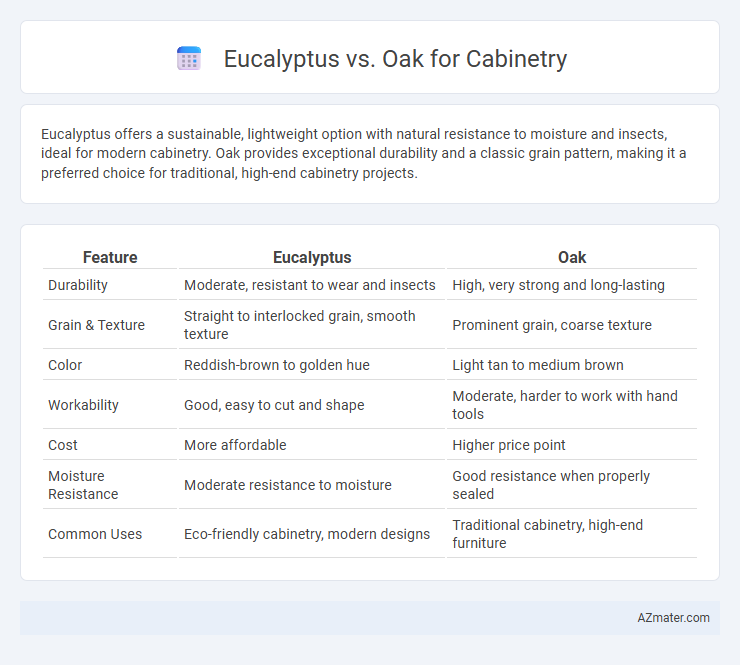Eucalyptus offers a sustainable, lightweight option with natural resistance to moisture and insects, ideal for modern cabinetry. Oak provides exceptional durability and a classic grain pattern, making it a preferred choice for traditional, high-end cabinetry projects.
Table of Comparison
| Feature | Eucalyptus | Oak |
|---|---|---|
| Durability | Moderate, resistant to wear and insects | High, very strong and long-lasting |
| Grain & Texture | Straight to interlocked grain, smooth texture | Prominent grain, coarse texture |
| Color | Reddish-brown to golden hue | Light tan to medium brown |
| Workability | Good, easy to cut and shape | Moderate, harder to work with hand tools |
| Cost | More affordable | Higher price point |
| Moisture Resistance | Moderate resistance to moisture | Good resistance when properly sealed |
| Common Uses | Eco-friendly cabinetry, modern designs | Traditional cabinetry, high-end furniture |
Introduction: Eucalyptus vs Oak Cabinetry
Eucalyptus and oak are popular hardwood choices for cabinetry, valued for their durability and aesthetic appeal. Eucalyptus offers a sustainable option with a distinctive grain pattern and natural resistance to moisture and pests. Oak provides a classic, timeless look with strong structural integrity and a wide range of finishes suitable for various interior designs.
Wood Characteristics and Grain Patterns
Eucalyptus offers a dense, hard texture with a fine, uniform grain, providing durability and a smooth finish ideal for cabinetry. Oak showcases a prominent, open grain pattern with distinctive rays and flecks, giving cabinets a traditional, rustic appeal and exceptional strength. Both woods resist wear well, but eucalyptus tends to have a more consistent appearance, while oak's complex grain adds character to furniture pieces.
Durability and Hardness Comparison
Eucalyptus wood offers moderate durability and hardness, making it a cost-effective option for cabinetry with decent resistance to wear and dents. Oak, particularly white oak, is highly durable and exhibits superior hardness, providing excellent longevity and resistance to impact in cabinetry applications. For kitchens or high-traffic areas, oak's robust grain structure and density typically outperform eucalyptus in maintaining structural integrity over time.
Color and Aesthetic Appeal
Eucalyptus offers a rich, warm reddish-brown hue with a smooth, consistent grain that enhances modern and rustic cabinetry designs. Oak features a classic, light to medium brown color with prominent grain patterns and natural knots, providing a traditional and timeless aesthetic. The choice between eucalyptus and oak for cabinetry largely depends on whether a sleek, contemporary look or a more classic, textured appearance is desired.
Workability for Cabinet Makers
Eucalyptus offers medium workability with good machining properties and a smooth finish but can be slightly harder to glue due to its high oil content, making it essential for cabinet makers to select appropriate adhesives. Oak, known for its excellent workability, machines well, cuts cleanly, and holds nails and screws effectively, though its open grain may require extra effort for a smooth surface finish. Cabinet makers often prefer oak for its reliable strength and easier bonding properties, while eucalyptus provides a durable alternative with a unique aesthetic if proper handling techniques are applied.
Cost and Availability
Eucalyptus offers a more affordable option for cabinetry due to its rapid growth and widespread availability in regions like Australia and the southern United States, compared to oak, which tends to be pricier due to slower growth and higher demand. Oak, especially white and red variants, remains readily available but commands higher prices because of its durability, grain patterns, and established reputation in fine furniture making. Cost-effective eucalyptus can be a sustainable choice for budget-friendly cabinetry, while oak's availability supports premium projects with a focus on longevity and classic aesthetics.
Environmental Impact and Sustainability
Eucalyptus offers rapid growth rates and high carbon sequestration, making it a highly renewable choice for cabinetry compared to Oak, which grows significantly slower and requires more extensive land use. Eucalyptus plantations can be sustainably managed with shorter harvest cycles, reducing deforestation pressures, whereas Oak harvesting often contributes to habitat loss and biodiversity decline due to its longer maturation period. The lower water consumption and resilience of Eucalyptus also enhance its environmental profile relative to Oak, promoting sustainable forestry and responsible resource use in furniture production.
Maintenance and Longevity
Eucalyptus cabinetry offers moderate maintenance with natural resistance to moisture and pests, making it suitable for humid environments, but it requires periodic sealing to preserve its durability. Oak, known for exceptional strength and hardness, demands less frequent upkeep due to its natural resilience against wear and tear, ensuring longevity even in high-traffic areas. Both woods benefit from regular cleaning and protective finishes, but oak's dense grain structure typically guarantees a longer lifespan in cabinetry applications.
Best Applications in Home Design
Eucalyptus wood offers a sleek, modern aesthetic with natural resistance to moisture and insects, making it ideal for kitchen cabinetry and bathroom vanities where durability and a contemporary look are essential. Oak, known for its strength and pronounced grain patterns, provides timeless appeal suited for traditional or rustic cabinetry in living rooms, dining rooms, and home offices. Choosing between eucalyptus and oak depends on desired durability, style preferences, and the specific environment's exposure to moisture and wear.
Final Verdict: Which Wood is Best for Cabinets?
Eucalyptus offers superior durability and resistance to moisture, making it ideal for cabinets in humid environments, while oak provides a classic grain pattern and excellent strength favored for traditional cabinetry. Oak's natural hardness allows it to withstand heavy use without denting, ensuring longevity in high-traffic rooms. For cabinetry, choosing eucalyptus ensures moisture resilience and modern aesthetics, whereas oak guarantees timeless beauty and robust performance, with the final decision hinging on environmental conditions and design preferences.

Infographic: Eucalyptus vs Oak for Cabinetry
 azmater.com
azmater.com